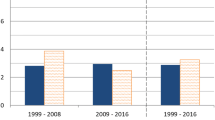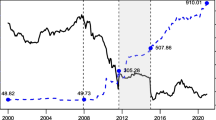Abstract
We analyze the link between macroeconomic fundamentals and exchange rate dynamics in two new and two potential EU member states: Bulgaria, Romania, Croatia, and Turkey. Given the different institutional settings of the exchange rate market in the countries of interest, we follow two different modelling strategies. For Romania and Turkey, we evaluate possible exchange rate misalignments based on a monetary model of exchange rate determination. In the case of Bulgaria and Croatia, with currency board and narrow-band peg arrangements against the euro, we discuss possible exit strategies and quantitatively assess the effects of the peg arrangements by means of simulation.




Similar content being viewed by others
Notes
For a literature survey on equilibrium exchange rate estimation with a focus on the new EU member states, see e.g. Égert (2003).
Extended working paper version with country specific information is in Reinhard and Rogoff (2002).
For a discussion on the pros and cons of euroization in Europe, see e.g. Begg et al. (2003). Although the academic literature generally uses the term dollarization for the predominant use of any foreign currency (and not necessarily the U.S. dollar) in a country, we use here the term euroization when referring to the predominant use of the euro in a country outside the euro area.
Detailed results of the structural parameter estimates are available from the authors upon request.
The close trade links of these countries with the euro area suggest that exchange rate movements against the euro are of higher relevance for exchange rate considerations than the fluctuations against other currencies, and in particular the U.S. dollar. We also performed estimations based on the exchange rate against the U.S. dollar, which are available upon request.
Égert and Lommatzsch (2004) present a discussion on the use of the CPI-to-PPI ratio as a proxy of the Balassa-Samuelson effect in Central and Eastern European economies.
Detailed results from different unit root tests applied to the variables are available from the authors upon request.
The DOLS and PL specification were estimated using three lags and leads of the first difference of the regressors and as many lags of the deviations of equilibrium as appeared significant (three or four, depending on the currency). The ADF test includes as many lags of the first difference of the error correction term as necessary to remove the autocorrelation in the residuals of the test equation (with a maximum of twelve lags).
The importance of production dynamics in short-run developments of the exchange rate of the Romanian leu was also highlighted by the Granger causality test results in Gueorguiev (2003) for the case of the exchange rate against the U.S. dollar.
We also estimated the model without specifying equal elasticities across countries, so that the different explanatory variables do not enter the model in relative terms but as individual variables for each country. The resulting misalignments do not lead to qualitatively different conclusions from those presented here. These results are available from the authors upon request.
For a recent assessment of exchange rate misalignments of the Turkish lira against the U.S. dollar see e.g. Özlale and Yeldan (2004).
Van Aarle et al. (2003) estimate monetary model of exchange rates extended by trade balances for eight CEECs.
In particular, we the parameters estimated for a smaller set of countries (excluding Turkey) and for shorter periods. These results are available from the authors upon request.
The results of panel unit root tests according to Im et al. (2003) are available from the authors upon request. We concentrate in estimations based on a single cointegration relationship, as implied by the theoretical model. The method by Larsson et al. (1998) would allow for more than one cointegration relationships, but this generalization is left as a future path of research.
Our sensitivity analyses show that this is especially attributable to the observations corresponding to Turkey. This may indicate that different shocks have occurred in Turkey and in other candidate countries in the mid-1990s. The results improve also if we use shorter time periods (e.g. from 1995 to 2003) for the estimation.
References
Aarle B van, Merlevede B, Plasmans J (2003) A Small macroeconomic model of the EU-accession countries. Open Econ Rev 14(3):221–250
Begg D, Eichengreen B, Halpern L, von Hagen J, Wyplosz C (2003) Sustainable regimes of capital movements in accession countries. CEPR Policy Paper (10, March 2003)
Billmeier A, Bonato L (2002) Exchange rate pass-through and monetary policy in croatia. IMF Working Paper, 02/109, IMF, Washington
Calvo GA, Reinhart CM (2002) Fear of floating. Quart J Econ CXVII(2): 379–408
Clark PB, MacDonald R (1998) Exchange rates and economic fundamentals – a methodological comparison of BEERs and FEERs. IMF Working Paper, 98/67
Crespo-Cuaresma J, Fidrmuc J, MacDonald R (2005) The monetary approach to exchange rates in the CEECs. Econ Transit 13(2):395–416
Duenwald C, Gueorguiev N, Schaechter A (2005) Too much of a good thing? Credit booms in transition economies: the cases of Bulgaria, Romania, and Ukraine. IMF Working Paper, 05/128, IMF, Washington
Égert B (2003) Assessing equilibrium exchange rates in CEE acceding countries: can we have DEER with BEER without FEER? A critical survey of the literature. Focus Transit 2:38–106
Égert Balazs, Halpern László (2006) Equilibrium exchange rates in central and eastern Europe: a meta-regression analysis. J Bank Finance 30(5):1359–1374
Égert B, Lommatzsch K (2004) Equilibrium exchange rates in the transition: the tradable price-based real appreciation and estimation uncertainty. William Davidson Institute Working Paper, 676, April 2004
Frankel JA (2003) Experience of and lessons from exchange rate regime in emerging economies. NBER Working Paper, w10032, October 2003
Ghosh AR, Gulde A-M, Wolf HC (2000) Currency boards, more than a quick fix? Econ Policy 31:269–335
Ghosh AR, Gulde A-M, Wolf HC (2002) Exchange rate regimes, choices and consequences. The MIT Press, Cambridge
Gueorguiev N (2003) Exchange rate pass-through in Romania. IMF Working Paper, 03/130
Groen JJJ (1998) The monetary exchange rate model as a long-run phenomenon. Tinbergen Institute Discussion Papers, 98-082/2
Groen JJJ (2002) Cointegration and the monetary exchange Rate Model Revisited. Oxf Bull Econ Stat 64(4):361–380
Im KS, Pesaran MH, Shin Y (2003) Testing for unit root in heterogenous panels. J Econ 115(1):53–74
International Monetary Fund (2000) Bulgaria: selected issues and statistical appendix. IMF Staff Country Report, 00/54
International Monetary Fund (2004) Bulgaria: selected issues and statistical appendix. IMF Staff Country Report, 04/177
Kao C (1999) Spurious regressions and residual-based tests for cointegration in panel data. J Econ 90(1):1–44
Kao C, Chiang M-H (2000) On the estimation and inference of cointegrated regression in panel data. Adv Econ 15:179–222
Larsson R, Lyhagen J, Löthgren M (1998) Likelihood-based cointegration tests in heterogeneous panels. Econ J 4:109–142
MacDonald R (1997) What determines real exchange rates? The long and short of it. IMF Working Papers, 97/21
Milesi-Ferretti GM, Razin A (1998) Current account reversals and currency crisis: empirical regularities. NBER Working Paper Series, 6620, Cambridge
Özlale Ü, Yeldan E (2004) Measuring exchange rate misalignment in Turkey. Appl Econ 36(16):1839–1849
Phillips PCB, Loretan M (1991) Estimating long-run economic equilibria. Rev Econ Stud 58(3):407–436
Reinhart CM, Rogoff KS (2002) The modern history of exchange rate arrangements: a reinterpretation. NBER Working Paper Series, 8963
Reinhart CM, Rogoff KS (2004) The modern history of exchange rate arrangements: a reinterpretation. Quart J Econ CXIX(1):1–48
Sinn H-W, Westermann F (2001) Why has the euro been falling? An investigation into the determinants of the exchange rate. NBER Working Paper Series, Cambridge
Stix H (2003) Survey result about foreign currency holdings in five central and eastern European countries. CESifo Forum 3:41–48
Stock JH, Watson MW (1993) A simple estimator of cointegrating vectors in higher-order integrated systems. Econometrica 61(4):783–820
Acknowledgments
We would like to thank an anonymous referee, Stephan Barisitz, Paul De Grauwe, Vivek Dehejia, Balázs Égert, Sylvester Eijffinger and Doris Ritzberger-Grünwald as well as the participants of the 79th Annual Conference of the Western Economic Association International in Vancouver, the 2005 Annual Meeting of the Austrian Economic Association National at the University of Innsbruck, the ZEW Summer Workshop on “EMU Enlargement” in Mannheim, the 90th International Conference of the Applied Econometrics Association on “Exchange Rate Econometrics” in Luxembourg and of in-house seminars held at the Oesterreichische Nationalbank for helpful comments and discussions.
Author information
Authors and Affiliations
Corresponding author
Rights and permissions
About this article
Cite this article
Crespo Cuaresma, J., Fidrmuc, J. & Silgoner, M.A. Fundamentals, the exchange rate and prospects for the current and future EU enlargements: evidence from Bulgaria, Croatia, Romania and Turkey. Empirica 35, 195–211 (2008). https://doi.org/10.1007/s10663-007-9057-9
Received:
Published:
Issue Date:
DOI: https://doi.org/10.1007/s10663-007-9057-9




